3.30.2010
Informal Learning and Leadership
3.29.2010
Performance and ADDIE Models
Clark Quinn has an informative post where he discusses the need for Performance Analysis, Learner Experience Design, and ADDIE. I think I have it somewhat summed up in this chart I created for my web site (note that clicking the chart will bring up a larger image that has clickable links):
Performance Design Concept Map
Click chart for a larger image & a clickable map that will take you to the various parts
Performance
ADDIE and other ISD and ID models were never designed to to discover performance problems, thus when confronted with such problems you need to discover the actual cause. Note the some managers will present every performance problem as a “training” problem, which means you need to ensure the problem is training related or requires some other performance solution.
The Performance Analysis Quadrant (PAQ) is a tool to help in the identification. By discovering the answer to two questions, “Does the employee have adequate job knowledge?” and “does the employee have the proper attitude (desire) to perform the job?” and assigning a numerical rating between 1 and 10 for each answer, will place the employee in 1 of 4 performance quadrants:
Performance Analysis Quadrant (PAQ)
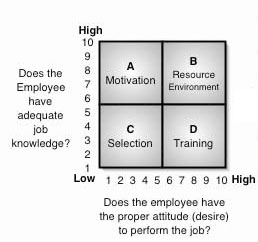
- Quadrant A (Motivation): If the employee has sufficient job knowledge but has an improper attitude, this may be classed as motivational problem. The consequences (rewards) of the person's behavior will have to be adjusted. This is not always bad as the employee just might not realize the consequence of his or her actions.
- Quadrant B (Resource/Process/Environment): If the employee has both job knowledge and a favorable attitude, but performance is unsatisfactory, then the problem may be out of control of the employee. i.e. lack of resources or time, task needs process improvement, the work station is not ergonomically designed, etc.
- Quadrant C (Selection): If the employee lacks both job knowledge and a favorable attitude, that person may be improperly placed in the position. This may imply a problem with employee selection or promotion, and suggest that a transfer or discharge be considered.
- Quadrant D (Training and or Coaching): If the employee desires to perform, but lacks the requisite job knowledge or skills, then some type of learning solution is required, such as training or coaching.
Learner Experience Design
Not only must you always use a tool, such as the one above to discover the true solution to a performance problem, ADDIE should almost never be used as a stand-alone solution. Being part of the ISD family, it is very broad in nature, thus it does not go into a lot of details. You need to use it as a plug and play solution — while Clark wrote of Learner Experience Design, you can add any additional components to it on an as-needed, such as Action Mapping, 4C/ID, and Prototyping.
ADDIE
Clark noted in his post that one of ADDIE's failures was being a waterfall method, but as I noted in a past post, ADDIE evolved into a dynamic method in the mid-eighties. ADDIE does make a good checklist; however, use it wisely. If you blindly follow it, then it is nothing more than a process model. However, if you use it in a more creative fashion, then it becomes a true ISD model that enhances the design of the learning process.
3.08.2010
ADDIE and the 5 Rules of Zen
As I noted in my last post, we often go astray with our learning initiatives because we fail to properly orient ourselves to the learning/performance environment. While ADDIE or ISD might look like an overblown, time-wasting toolkit, we need to realize that we do not need every tool within that kit. Every project requires a different set of tools. However, there are a few basic ones that will give you direct intuitive insight into the problem at hand. While there are several Zen rules that govern the aesthetics of Japanese gardens and other art forms in Japan, five of them can be directly applied to ADDIE to aid you in creating an energized, but calm learning platform (inspired by a Presentation Zen post).
Analysis = Shizen (自然)

Shizen means naturalness in that it avoids artificial construction. This means analysis must be sought for and expressed in a plain, simple, and natural manner. To get to its natural roots, describe the business need in terms of the performance desired and where they are now. Everything between their present state and desired performance is the performance gap. This gap must be bridged by identifying the skills and knowledge that enable the learners to perform.
Shizen also applies to the learners. Learning becomes difficult when we have to learn new concepts because we have no relationship to them, thus we construct artificial backgrounds. However, when we relate to a new concept naturally by linking it to an experience that is familiar to us, then we learn much faster and deeper. This is why we need to capture the present performance of the learners so that we can create “Advance Organizers” that will link the learner's new knowledge to this present performance or knowledge level. Learners who are given Advance Organizers at the beginning of a learning process have been shown to increase transfer of training.
Design = Shibui/Shibumi (渋味)

Shibui is coolness and beauty through a clear design and nothing more. Think of design as minimalist that articulates brevity. If you decorate or carry it beyond what it was meant to be, then it becomes gauche rather than deco. Think lean by identify the minimal steps and activities that will enable the learners to master the performance rather than rather than overdoing it by including every possibility. To help transform the learning from an activity to a process and reduce the complexity of training; determine the support, such as tools and performance aids, they will need to enable their performance in the workplace.
Development = Fukinsei (均整)
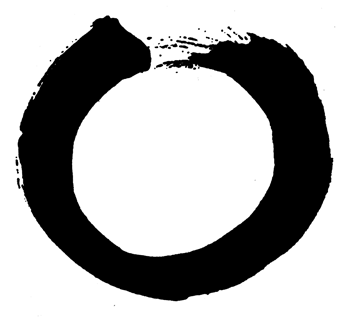
Fukinsei means asymmetry or irregularity. Controlling balance through the use of irregularity and asymmetry is a central belief in Zen aesthetics. For example, the enso or Zen circle is often incomplete to symbolize the asymmetry. Too often we try so hard to create the perfect learning platform by filling in all the blanks that it fails to draw the learners in — we tend to be drawn in more when we can fill in some of the blanks on our own. Designers also tend to carry it to the extreme by adding too much content — it overwhelms the learners with too much information. Thus we need to strive for some incompleteness, irregularity, and/or asymmetry in order to draw the soon-to-be performers into the learning process.
Fukinsei design also implies a deductive approach. That is, rather than being presented with a complete set of concepts, rules, and strategies, that explicitly instructs the learners, they must explore and experiment with the task to infer and learn the rules, principles, and strategies for effective performance (discovery or experimental learning). This approach has been shown to build “Adaptive Expertise” — becoming more adaptable in order to solve unstructured and ill-defined problems. Also closely related to this is “Error-based Learning” to allow for more control processing.
“Nature itself is full of beauty and harmonious
relationships that are asymmetrical yet balanced.
This is a dynamic beauty that attracts and engages.”
- Garr Reynolds
Implement = Kanso (簡素)
Kanso means simplicity by eliminating the unneeded things (clutter) to find the clear structure. Clear structure does not necessarily mean a linear list, but rather a choice of options. However, when it comes to practicing the skills, ensure it includes whole-task practice that will help to carry performance to the workplace.
A Kanso style choice of options is also critical as providing learner control has been shown to also build “Adaptive Expertise.”
Evaluation = Seijaku (静寂)

Seijaku is tranquility or an energized calm. An effective learning platform should bring a sense of peace to the organization by eliminating the gap between the present performance and the desired performance identified in the analysis phase. The use of iterations will allow you to quickly lower the unintentional noise and disturbance. Continue iterating until the disturbance has been transformed into the desired state of tranquility.
Seijaku should also be carried one step farther — having the learners participate by monitoring and evaluating in order to help them increase their metacognitive skills.
Picture Credits
deco by Ohad. enso circle by Vibhav. bamboo/rocks and dock by istock. pods and bento by me.
3.02.2010
Creating a Learning Platform for Boyd's OODA Loop
In my last post I talked about getting more out of AARs by incorporating them with informal learning and social media tools and then pushing it with formal learning in order to capture lessons learned. This approach allows you to set up a learning strategy that is a real process rather than a one time event. Similar approaches can be done with the OODA loop.
Although originally developed for fighter pilots and then adapted by the Armed Forces, Boyd's OODA Loop is now used by organizations as a decision-making tool that a person or team cycles through as rapidly as possible to help them to stay ahead of their competitors.
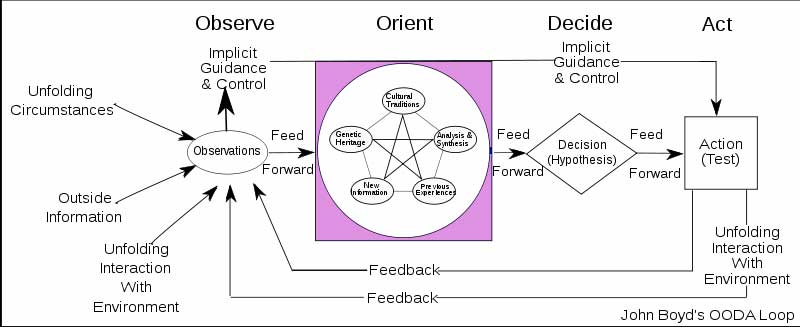
It is composed of four actions (Observe, Orient, Decide, Act).
Observe
In this part of the action loop the observer scans the environment in order to gather information and learn about it. However, in this day of abundant information, think more of applying the right filters to gather the information that will be most useful to you. As Clay Shirky notes, “It's Not Information Overload. It's Filter Failure:”
While we are still far from having the perfect filters, we are at least heading in the right direction. For example, I have a list of some of the resources that I use, to include on-line publications, discussion groups, web sites, and blogs that provide me with information about the learning industry. The ones with RSS feeds provide the most value as they feed into my primary browser (Safari) and its is set up so that I only get a small portion of the content. Thus I can quickly scan the latest feeds and then click on them if I determine they have information that interests me. Organizations can help their workers by setting up master portals of relevant links and feeds for each of their various workgroups, and then using a learning platform to help the workers to select the ones that pertain to them the most so they can build their own personal learning environment (PLE) for scanning their environment.
Another useful tool is the ones that belong in the microblogging category, such as Twitter or Yammer, that not only allows our network to send us relevant information and vice-versa, but also allows us to ask for help when we are trying to find information. This may also require a learning platform that will help the workers to learn to send useful information without flooding their coworkers with useless information.
In addition, organizational blogs allow the workers to easily publish their observations so that others may benefit from them. An added benefit is that the readers can provide comments so that the observer/writer receives feedback as discussed in the next part of the action loop — Orient.
Orient
The second part of the action loop is synthesizing the data and information gathered during "observing" into a mental image of the circumstances. As more information is received, you "deconstruct" old images and "create" new images. Within this part of the action loop you have to question past beliefs to see if they still hold true when compared to the new information.
This is perhaps the hardest part of the four actions because we basically fail to ask the right questions and to question our beliefs. For example, Chris Argyris discovered that even highly educated adults stick with Single-Loop Learning rather than using Double-Loop Learning by questioning underlying assumptions:
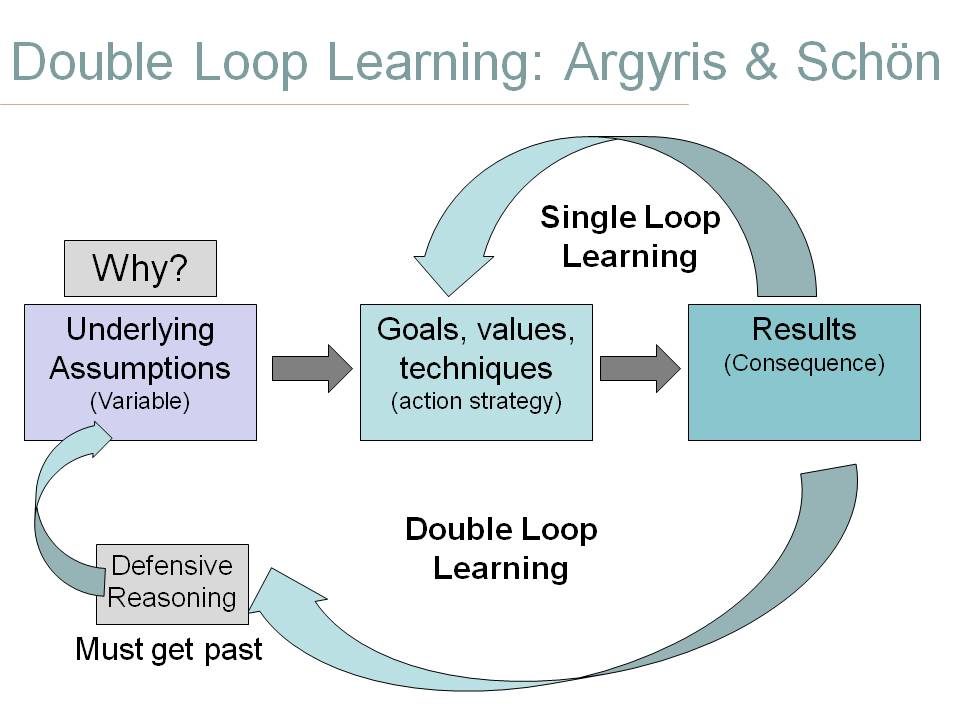
Another example is the Army, who is best known for creating teams rather than groups, having to create a special environment (AAR) so that the troops could learn from their mistake rather than playing the blame game.
Boyd also noticed this phenomenon in that he spent most of his time emphasizing orient in the OODA loop.
The learning profession also shows this trait of failing to orient themselves in that they rush through the analysis part of a project so fast they fail to properly align the learning platform with real business needs. Secondly, they fail to scan the environment far enough ahead, so rather than designing learning processes, they end up with a learning event that fails to transfer to the workplace. And finally, they fail to evaluate their original beliefs, thus rather than capturing lessons learned, they are doomed to a cycle of repeating their mistakes. No wonder we always hear the old mantra, “ADDIE must die!” — we would rather rush ahead with ill-designed rapid development programs that simply concentrate on development and delivery, rather than properly orientating ourselves to the present environment.
Not only do we fail to question our beliefs, but when we ask others for feedback, they normally evaluate before trying to fully understand. Carl Rogers discovered five main categories of feedback. They are listed below in the order in which they occur most frequently in daily conversations:
- Evaluative: Making a judgment about the worth, goodness, or appropriateness of the other person's statement.
- Interpretive: Paraphrasing - attempting to explain what the other person's statement means.
- Supportive: Attempting to assist or bolster the other communicator.
- Probing: Attempting to gain additional information, continue the discussion, or clarify a point.
- Understanding: Attempting to discover completely what the other communicator means by her statements.
Notice that we often make judgments more often than we try to understand.
Thus a formal learning strategy is needed to help the workers develop skills that allow them to question their beliefs and asking probing questions to see if their beliefs are still valid. In addition, this needs to stretch in the other direction so that when others ask for our opinions, we use the five categories of feedback in the proper direction — we gain a level of understanding by using probing, supportive, and interpretive feedback before we provide an evaluation.
Secondly, the microblogging tools mentioned in the Observing portion of the action loop can be used just as effective, if not more, to get the a broader range of opinions from others.
In addition, the use of wikis or other social editing tools, allow teams performing the OODA Loop to rapidly edit group documents as they reorient themselves.
Decide
The use of PLEs with RSS feeds, blogs, microblogging tools, and wikis in the OODA loop allows the workers to consider all the options and select a subsequent course of action.
Act
This is where you carry out the conceived decision. Once the result of the action is observed, you start over. However, before you do, capture lessons learned by using an AAR so that learning becomes part of the natural process:
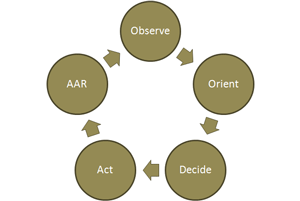
Note that in combat (or when competing against your competitors), you want to cycle through the four action steps faster and better than the enemy, hence, it is a loop.


